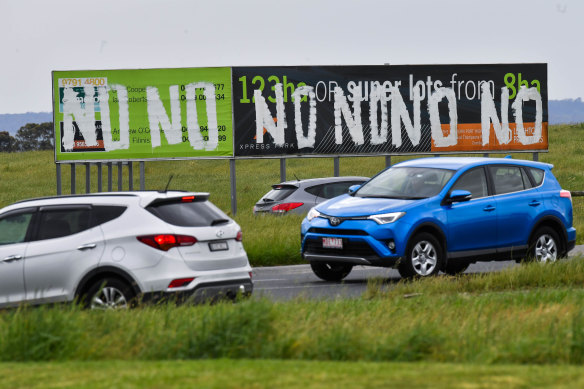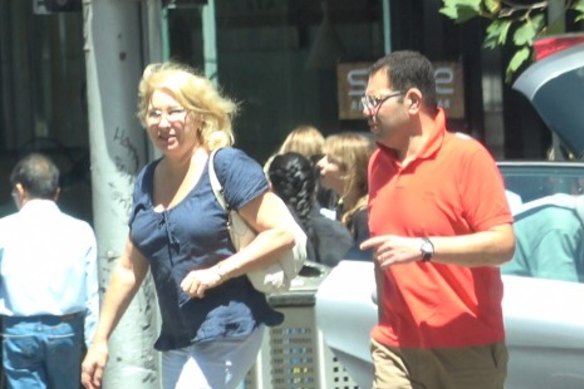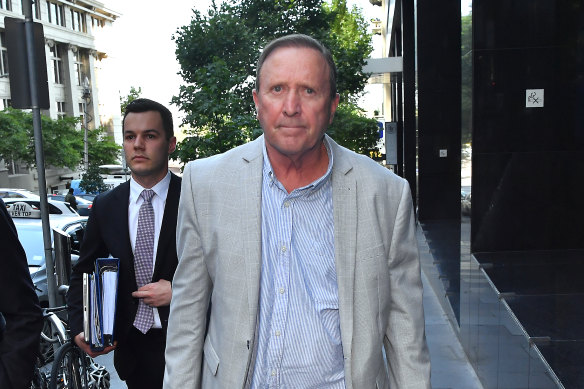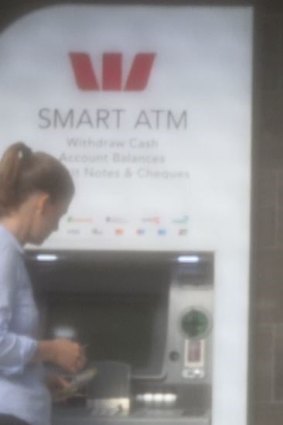By Royce Millar and Ben Schneiders
If you’d offered the Casey land scandal as an idea for a political thriller two months ago, any credible publisher would have sent it back for more work, saying the protagonist was a film noir cliche and the plot badly overcooked.
At the centre of this pot-boiled political thriller is an ageing, gold chain-wearing, Ferrari-driving developer by the name of John Charles Woodman (aka JCW), who dines with the Premier in Chinatown and counts an alleged mafia boss among his clients. He’s made a fortune over decades duchessing local residents' groups, councils and governments and he and his partners have $100 million riding on one last big property deal - the attempt to rezone a piece of industrial land in the conservative-voting Bible belt of outer Melbourne.
So he throws everything at it, splurging millions on bribes and political donations, seizing effective control of the local council and applying influence and pressure to state MPs as an election looms. After a clandestine meeting in a far-flung Subway, a down-on-her-luck former Liberal MP (Lorraine) couriers cash in envelopes between the developer and a former mayor (Sam, who later flees to Egypt).
Over four years of graft and intrigue the developer manipulates the rezoning all the way to the minister’s desk for signing. The $100 million is all but pocketed.
Then a journalist makes a call and the process suddenly stops.

Local residents oppose the rezoning of the Cranbourne West farmland being pushed by John Woodman. Credit: Joe Armao
But this is not a script. It’s Victoria now. Over three weeks of extraordinary public hearings the Independent Broad-based Anti-corruption Commission (IBAC) has heard alleged evidence of blatant property-based graft, making its Operation Sandon the most significant probe of Victorian planning in decades.
The most explosive investigation in IBAC's short seven-year existence has focused on issues raised by The Age and The Sunday Age dating back to 2011 and including major revelations in late 2018 about Woodman’s outsized political influence.
This inquiry is not just about one council and one developer. It has exposed gaping holes in governance and legislation at the local and state level. IBAC finds itself confronting not just corruption but core questions about how we plan our city and who stands to gain.
For five years the Andrews government has carefully and strategically kept planning and development economics off the front pages of our newspapers. That long honeymoon is over.
Shaking the state
So complete was developer John Woodman’s control of Casey councillors until late last year that the counsel assisting IBAC, Michael Tovey QC, described them as “puppets”. So brazen were the alleged corruption scams run by Woodman that, when the heat came on, he was caught on a phone tap telling one of his accomplices: “I don’t know how you and I ... are not going to finish up in jail.”
Both political parties have been caught in the scandal. Former Liberal MPs, mayors and candidates and Daniel Andrews’ Labor government have been shaken. The IBAC hearing has laid bare Woodman’s deep Labor connections - including with the Premier himself - the number and purpose of donations made in 2018 and the reality of backbenchers lobbying on his behalf within the government.
At the grassroots level the Casey scandal has exposed major failings in the administration and monitoring of local government. Throughout the hearings IBAC commissioner Robert Redlich QC listened incredulously to evidence of council processes being abused and councillors failing to record and declare conflicts of interest.

Councillor Sam Aziz and lobbyist Lorraine Wreford in undercover vision.Credit: IBAC
Of the current 11 Casey councillors, a clear majority have received Woodman's largesse, including two - former mayors Sam Aziz and Geoff Ablett - who shared at least $1.2 million in alleged bribes. At the 2016 council election, Woodman spent almost $100,000 running what he called his "team" of about 10 mostly Liberal-aligned candidates and separately donating to both Liberal and Labor-linked councillors.
In the witness box Woodman acknowledged that election was just the most recent of his forays into Casey. He confirmed spending about $50,000 at each poll going back for an unspecified period.
Under the Local Government Act there is no cap on the level of gifts or donations that a councillor or council candidate may receive. It’s a gaping hole in state legislation and one that IBAC has shown keen interest in. The Act requires that councillors declare any campaign donations of $500 or more. Remarkably, while the evidence before IBAC suggests most of the current Casey councillors received campaign contributions, none appear to have declared them.
Despite repeated requests for comment, no sitting councillors have been prepared to talk to The Age about such matters since Operation Sandon became public in October.
Councillors are also supposed to declare conflicts of interest and absent themselves from voting when applications involving donors come before them. This requirement too has been routinely breached at Casey.
Woodman-related companies are ubiquitous in Casey, with hundreds of applications before the council in any one year. Many of the biggest and most controversial projects before council in recent years have involved Woodman-linked companies.
But one project in particular has been of interest to IBAC - the proposal led by Woodman to rezone a swathe of Cranbourne West land owned by construction giant Leighton (now known as CIMIC) from industrial land to more lucrative residential use.
The rezoning required the approval of the council and Planning Minister Richard Wynne. Had that happened it would have delivered Woodman and his consultants millions of dollars, and Leighton a $100 million windfall. Now the subject of one of the Andrews government’s biggest controversies, the rezoning remains unresolved on Wynne’s desk. The commission heard its progress stopped dead after The Age started asking questions about Woodman's influence.
An analysis by The Age indicates that across council candidates and elected councillors there were more than 50 instances of failure to record or declare campaign gifts or conflicts over the past five years. Councillors have repeatedly voted on projects from which they should have absented themselves, and failed to declare conflicts.

Councillor Geoff Ablett outside IBAC.Credit: Joe Armao
IBAC also heard how Ablett, when he did belatedly declare a conflict and absented himself from voting on Woodman-related projects, then "coached” other councillors about how to vote, behaviour described by commissioner Redlich as a "most flagrant abuse” of conflict-of-interest rules.
Beyond Casey
While the current inquiry is primarily concerned with the behaviour of a single council, Redlich fears the problems may be more widespread. On Friday he stressed that in 2020 IBAC would continue to explore the development industry’s influence on decision-making “within Victoria”.
Woodman himself acknowledged that his calculated intervention in local politics was not limited to Casey and that over the years he had used similar “analysis” of councils to win approval for major marina and residential developments including the $650 million Martha Cove on the Mornington Peninsula.
But it's not only developers applying pressure and supplying lures to councillors. The Casey case has again turned the spotlight on lobbyists and consultants, the conduits and go-betweens often linked to political parties.
IBAC has heard extensively from Megan Schutz, a former senior state government planner and lawyer who pushed and coached councillors on behalf of Woodman.

Mr Woodman's assistant takes cash out of an ATM.Credit: IBAC
Former Casey mayor and one-time Liberal MP for Mordialloc Lorraine Wreford carried cash between Woodman and Aziz and was Woodman’s mouthpiece to one group of Liberal-linked councillors. Lifetime ALP member and one-time parliamentary candidate Phil Staindl was the Labor connector, working mainly at the state level.
Ten years ago the Brumby Labor government established a special register requiring lobbyists to record minimum details including the names of their clients and listing any positions previously held within government.
But Wreford is not on the state lobbyists' register and told the IBAC hearing she did not know there was one. She is, however, listed on an equivalent federal register.
The Andrews government can expect IBAC to press for a toughening of rules around lobbyists, including a requirement for them to record meetings with local and state politicians.
Labor's links
The state government has sought to spin Operation Sandon as a probe of allegedly corrupt Liberal councillors. But IBAC has heard how Woodman has spent $400,000 on state parties and candidates in the past decade alone, favouring the Liberals in 2014 and then hot favourites Labor in 2018 with a whopping $160,000.
Among the beneficiaries through the years have been Premier Andrews, his deputy James Merlino, Racing Minister and former attorney-general Martin Pakula and a string of other front and backbenchers including local MPs in the Casey area.
In November last year The Sunday Age revealed how local MPs Jude Perera and Judith Graley (both now retired) had received thousands of dollars in donations from Woodman and had lobbied on his behalf for the Cranbourne West rezoning.
IBAC has revealed that Perera’s successor, Pauline Richards, followed suit, with the receipt of thousands of dollars from Woodman, who was confident that she would work to get his crucial Cranbourne West rezoning approved.
Throughout the hearings Redlich raised the issue of developer donations to both council and state candidates on numerous occasions. Woodman confirmed that he’d got help from the major parties about how to hide his donations by contributing under the public disclosure threshold - currently $13,800.
From the witness box Woodman and Schutz acknowledged that donations gave them access to politicians they would not otherwise have had. Remarkably, Woodman agreed that the law was deficient in controlling access through political money.
In late 2017 the Andrews government announced a major reform of Victoria’s notoriously lax donations regime, including a cap on donations of $4000 over the four-year parliamentary term - effectively $1000 a year. But these changes did not kick in until after the 2018 election and Woodman's $160,000 contribution that year.
IBAC has now flagged it will call on the state government for a further toughening of donations laws, especially for developers, at the state and local level at least. Despite years of debate, however, there is no sign of reform at the federal level, where donations remain uncapped.
Unearned windfalls
The Casey scandal goes to the heart of a much bigger and more politically problematic issue than donations and governance. It’s no coincidence that the biggest planning scandal in Victoria since the land deals of the 1970s has centred on this council area, one of the fastest-growing municipalities on Melbourne’s urban fringe.
No city in Australia sprawls like Melbourne, which - unlike Sydney - is not constrained by natural barriers. Time and again the major parties have promised to rein in spread that eats into prime farmland.
Part of the explanation is the influence of a development industry cashed up with the windfalls that come from turning farmland into housing. An important IBAC case study is Brompton Lodge, an egg farm in Cranbourne South that was rezoned to residential by the Baillieu government in 2012 with backing from an earlier Casey council.
The rezoning became controversial when The Age revealed in 2011 the role of Woodman, lobbyists and donations to both local councillors and the Liberal party.
Woodman told the IBAC hearing that the 100-hectare property had appreciated in value from $5000 to $600,000 per acre once it was rezoned and prepared as housing lots. The landowner, the Carpenter family, bought the property for about $70,000 in the 1970s and sold it for $55 million, an extraordinary 785-fold growth in value.
Critics have long argued that such profits are irresistible to speculators and developers and can be used to pressure local and state politicians to continue opening up the urban frontier, as has happened at Casey. Inevitably, IBAC has confronted such issues in the past three weeks.
Prominent planning expert Marcus Spiller has argued for years that the way to address the problem is to slash the windfall that landowners enjoy from simply waiting for a council decision and the stroke of a minister’s pen. He has called for the introduction of a costly “licence” that would eat into those windfalls, reduce speculative pressure and deliver big dollars for sorely needed public infrastructure such as transport and social housing.
Whether IBAC is prepared and able to wrestle with such delicate political matters remains to be seen.
However on Thursday the counsel assisting IBAC, Michael Tovey, quizzed Woodman’s planner and lawyer associate, Megan Schutz, asking whether it was reasonable that “someone who has a farm one day and does nothing other than secure a rezoning should be entitled to the profits that a government decision generates”?
"That is a philosophical question,” she responded.
“It’s allowed by the system at the moment.”
Reforms that could flow from the Casey scandal
- A total ban on developer donations at local and state level
- Tightening the rules around councillor conflicts of interest
- Dramatic improvement of councillor training
- Toughening of rules around lobbyists
- Review of the role of resident action groups
- Review of developer windfalls from land rezoning